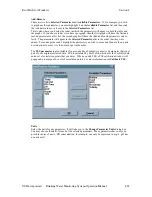
Principles of Operation
Section 5
YSI Incorporated Drinking Water Monitoring Systems Operation Manual
5-4
2 – Reagants to confirm ORP sensitivity are available. Contact YSI Customer Service for ordering
information.
3 - ORP readings usually stabilize much more rapidly in standards (e.g., Zobell solution) than in most
environmental water. Be certain to consider this factor when determining ORP in field studies.
4 - Clean and store the pH/ORP sensor by following the instructions in
Section 2.10, Care,
Maintenance
and Storage
of this manual.
5.5
5.5
5.5
5.5 ppppH
H
H
H
The sondes employ a field replaceable pH electrode for the determination of hydrogen ion concentration.
The probe is a combination electrode consisting of a proton selective glass reservoir filled with buffer at
approximately pH 7 and a Ag/AgCl reference electrode that utilizes electrolyte that is gelled. A silver wire
coated with AgCl is immersed in the buffer reservoir. Protons (H
+
ions) on both sides of the glass (media
and buffer reservoir) selectively interact with the glass, setting up a potential gradient across the glass
membrane. Since the hydrogen ion concentration in the internal buffer solution is invariant, this potential
difference, determined relative to the Ag/AgCl reference electrode, is proportional to the pH of the media.
The pH system of the 600R utilizes individual glass sensing and reference electrodes, but the operating
principle is the same.
Our testing of the 6561 pH, 6565 and 6566 pH/ORP sensors and 600R pH system indicates that they should
provide long life, good response time, and accurate readings in most environmental waters, including
freshwater of low ionic strength. Thus, no special sensor is required (nor offered) for water of low
conductivity.
CALIBRATION AND EFFECT OF TEMPERATURE
The software of the sondes calculates pH from the established linear relationship between pH and the
millivolt output as defined by a variation of the Nernst equation:
E = E
o
+ 2.3RT * pH where E = millivolts output
nF
E
o
= a constant associated with the reference electrode
T = temperature of measurement in degrees Kelvin
R, n, and F are invariant constants
Thus, in simplified
y = mx + b
form, it is (mv output) = (slope)x(pH) + (intercept). In order to quantify this
simple relationship, the instrument must be calibrated properly using commercially available buffers of
known pH values. In this procedure, the millivolt values for two standard buffer solutions are
experimentally established and used by the sonde software to calculate the slope and intercept of the plot of
millivolts vs. pH. Once this calibration procedure has been carried out, the millivolt output of the probe in
any media can readily be converted by the sonde software into a pH value,
as long as the calibration and
the reading are carried out at the same temperature.
This last qualifier is almost never met in actual
environmental measurements since temperatures can vary several degrees during a deployment simply
from a diurnal cycle. Thus, a mechanism must be in place to compensate for temperature or, in other
words, to accurately convert the slope and intercept of the plot of pH vs. millivolts established at T
c
(temperature of calibration) into a slope and intercept at T
m
(temperature of measurement). Fortunately, the
Nernst equation provides a basis for this conversion.
According to the Nernst equation as shown above, the slope of the plot of pH vs. millivolts is
directly
proportional
to the absolute temperature in degrees Kelvin. Thus, if the slope of the plot is experimentally
determined to be 59 mv/pH unit at 298 K (25 C), then the slope of the plot at 313 K (40 C) must be
(313/298) * 59 = 62 mv/pH unit. At 283 K (10 C), the slope is calculated to be 56 mv/pH unit ((283/298) *
Содержание 600DW-B
Страница 3: ......
Страница 239: ...Principles of Operation Section 5 YSI Incorporated Drinking Water Monitoring Systems Operation Manual 5 26...
Страница 251: ...Warranty and Service Information Section 8 YSI Incorporated Drinking Water Monitoring Systems Operations Manual 8 4...
Страница 259: ...Required Notice Appendix B YSI Incorporated Drinking Water Monitoring Systems Operations Manual B 2...
Страница 264: ...EMC Performance Appendix D YSI Incorporated Drinking Water Monitoring Systems Operations Manual D 2...
Страница 268: ...Specifications Appendix E YSI Incorporated Drinking Water Monitoring Systems Operations Manual E 4...
Страница 297: ......
















































